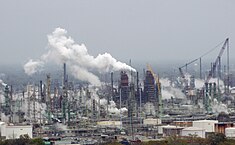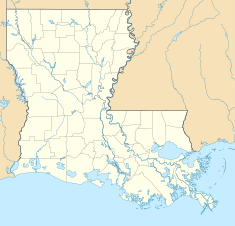Baton Rouge Refinery
 Baton Rouge Refinery seen from the Louisiana State Capitol, looking north | |
| Country | United States |
|---|---|
| Province | Louisiana |
| City | Baton Rouge |
| Coordinates | 30°29′1″N 91°10′50″W / 30.48361°N 91.18056°W |
| Refinery details | |
| Owner(s) | ExxonMobil |
| Commissioned | 1909 |
| Capacity | 540,000 bbl/d (86,000 m3/d) |
| No. of employees | 4000 |
ExxonMobil's Baton Rouge Refinery in Baton Rouge, Louisiana is the sixth-largest oil refinery in the United States and seventeenth-largest in the world,[1] with an input capacity of 540,000 barrels (86,000 m3) per day as of January 1, 2020.[2] The refinery is the site of the first commercial fluid catalytic cracking plant that began processing at the refinery on May 25, 1942.[3]
Standard Oil first erected the refinery in 1909. Today's facility is part of a complex made of nine individual plants across the region. The main plant is located on the east bank of the Mississippi River. There are about 6,300 workers spread across these sites, including 4,000 direct employees (the rest are contractors).
In 2013 Genesis Energy LP announced an investment of $125 million to improve ExxonMobil's existing assets in the Baton Rouge area. The investment includes plans to build an 18-mile (29 km), 20-inch (51 cm) diameter crude oil pipeline that connects Genesis Energy's Port Hudson terminal, to ExxonMobil's Baton Rouge refinery.[4]

Units
[edit]Petroleum refining units
[edit]According to ExxonMobil's filings with the US DOE's Energy Information Agency, the unit capacities for the Baton Rouge Refinery are presented below:[5]
| Unit | Capacity in BPCD |
|---|---|
| Total Refinery Nameplate | 544,600 |
| Atmospheric Distillation | 544,600 |
| Vacuum Distillation | 254,000 |
| Delayed Coking | 123,500 |
| FCC | 243,000 |
| Hydrocracker | 27,000 |
| ULSD Hydrotreating | 215,800 |
| Gasoline & Naphtha Hydrotreating | 261,000 |
| Naphtha Reforming | 80,000 |
| Alkylation | 41,000 |
| Lubricants Production | 16,500 |
| Petcoke mt | 31,525 |
The refinery undertook a $230 million[6] investment to modernize the crude unit and expand crude flexibility as part of the BRRIC program with plans to increase exports of clean fuels.[7] The project involved up to 600 contractors and took place over 3 years.[8]
ExxonMobil is also considering a biofuels project to be constructed at the Baton Rouge site. [9]
Electricity generation
[edit]The refinery operates is own powerplant with the following detail:[10]
| Unit name | Status | Fuel(s) | Capacity (MW) | Technology | CHP | Start year |
|---|---|---|---|---|---|---|
| CTG1 | Operating | fossil gas: natural gas | 85 | gas turbine | yes | 1990 |
PetroChemical production
[edit]The ExxonMobil Chemical division operates a steam cracker that is integrated with the refinery and has an output of 975,000 mt per year of ethylene.[11]
Environmental permits
[edit]The refinery operates with a Title V Air Major permit covering its emissions. The facility ID is LA0000002203300015 for the air permit which is the most important permit controlling the emissions thresholds of the plant. The permit summary is below.[12]
| Statute/Program | Universe | Media | Identifier |
| Clean Air Act (CAA) | Air Minor | Air | LA0000002203300168 |
| Clean Air Act (CAA) | Air Minor | Air | LA0000002203300180 |
| Clean Air Act (CAA) | Air Major | Air | LA0000002203300015 |
| Clean Water Act (CWA) | NPDES Major | Water | LA0005584 |
| Clean Water Act (CWA) | Storm Water Industrial | Water | LAR05N757 |
| Clean Water Act (CWA) | NPDES Non Major | Water | LAR05N757 |
| Resource Conservation and Recovery Act (RCRA) | VSQG | Land | LAR000067942 |
| Resource Conservation and Recovery Act (RCRA) | LQG | Land | LAD062662887 |
| Resource Conservation and Recovery Act (RCRA) | TSD | Land | LAD062662887 |
| Greenhouse Gas Reporting Program (GHGRP) | Greenhouse Gas Reporter | Air | 1007643 |
Greenhouse gas emissions history
[edit]As a major emitting facility, The ExxonMobil Baton Rouge Refinery and Petrochemical Site must report its complete greenhouse gas emissions to the EPA every year subject to the EPA's Greenhouse Gas Reporting Program. The Baton Rouge reports as four separate facilities but with the integrated refinery and olefins unit being the largest and accounting for >95% of emissions. The reporting codes are below:[13]
| Facility Name | EPA Facility ID | FRS ID |
|---|---|---|
| EXXONMOBIL BATON ROUGE REFINERY AND CHEMICAL PLANT | 1007643 | 110043804185 |
| EXXONMOBIL CHEMICAL CO - BATON ROUGE POLYOLEFINS PLANT | 1006801 | 110000450011 |
| EXXONMOBIL CHEMICAL CO - BATON ROUGE PLASTICS PLANT | 1003484 | 110070834663 |
| Exxon Mobil Corporation-Baton Rouge Resin Finishing Plant | 1014575 | 110071165420 |
The greenhouse gas emissions by year are reported below:[14]
| Year | Total Reported
Direct Emissions |
CO2 Emissions
Non-Biogenic |
Methane
Emissions |
Nitrous Oxide
Emissions |
|---|---|---|---|---|
| metric ton | metric ton | metric ton | metric ton | |
| 2023 | 5,914,862 | 5,883,262 | 17,160 | 14,440 |
The Baton Rouge Refinery is one of the ten largest emitting refineries in the United States according to Reuters. However, it is also a top ten refinery in size and complexity and is deeply integrated with its petrochemical business.[15]
See also
[edit]References
[edit]- ^ List of oil refineries#World.27s largest refineries
- ^ "2018 Baton Rouge Refinery fact sheet" (PDF). 2018. Retrieved September 26, 2020.
- ^ "The Fluid Bed Reactor" (PDF). American Chemical Society. November 3, 1998. Retrieved September 26, 2020.
- ^ Perilloux, Gary (February 4, 2013). "Genesis Energy To Invest $125 Million In Baton Rouge Area Infrastructure Project". Louisiana Economic Development. Retrieved September 26, 2020.
- ^ "Data & Statistics". www.afpm.org. Retrieved 2024-10-24.
- ^ Lowe, Dillon (2024-01-19). "ExxonMobil completes $230M upgrade of Baton Rouge refinery". Baton Rouge Business Report. Retrieved 2024-10-30.
- ^ Tobben, Sheela (2024). "Another BRRIC in the Wall - Baton Rouge Refinery Set to Access More Crudes, Boost Exports After Modernization". RBN Energy LLC.
- ^ "ExxonMobil BRRIC Update 2021" (PDF). ExxonMobil.
- ^ Stewart, Robert (2024-02-07). "Biofuels could be coming to Baton Rouge refinery, ExxonMobil CEO says". The Advocate. Retrieved 2024-10-30.
- ^ "ExxonMobil Baton Rouge Turbine Generator power station". Global Energy Monitor. Retrieved 2024-11-12.
- ^ Koottungal, Leena (2015-07-07). "International survey of ethylene from steam crackers - 2015". Oil & Gas Journal. Retrieved 2024-11-12.
- ^ "TRI Facility Report". enviro.epa.gov. Retrieved 2024-10-24.
- ^ US EPA, OAR (2015-05-18). "Data Sets". www.epa.gov. Retrieved 2024-11-01.
- ^ US EPA, OAR (2015-05-18). "Data Sets". www.epa.gov. Retrieved 2024-11-12.
- ^ Mclaughlin, Tim (2021). "Insight: Three Exxon refineries top the list of U.S. polluters". Reuters.

